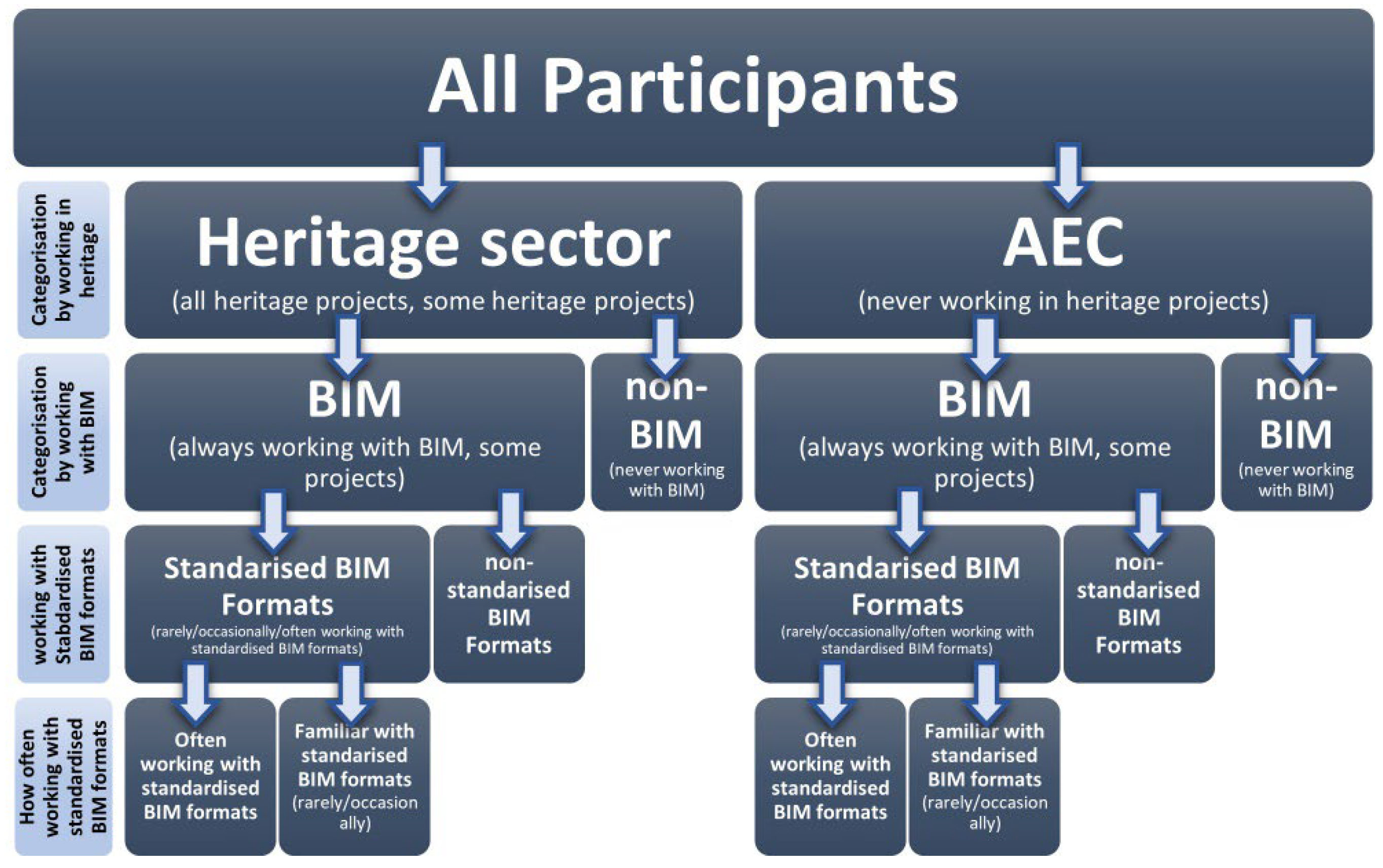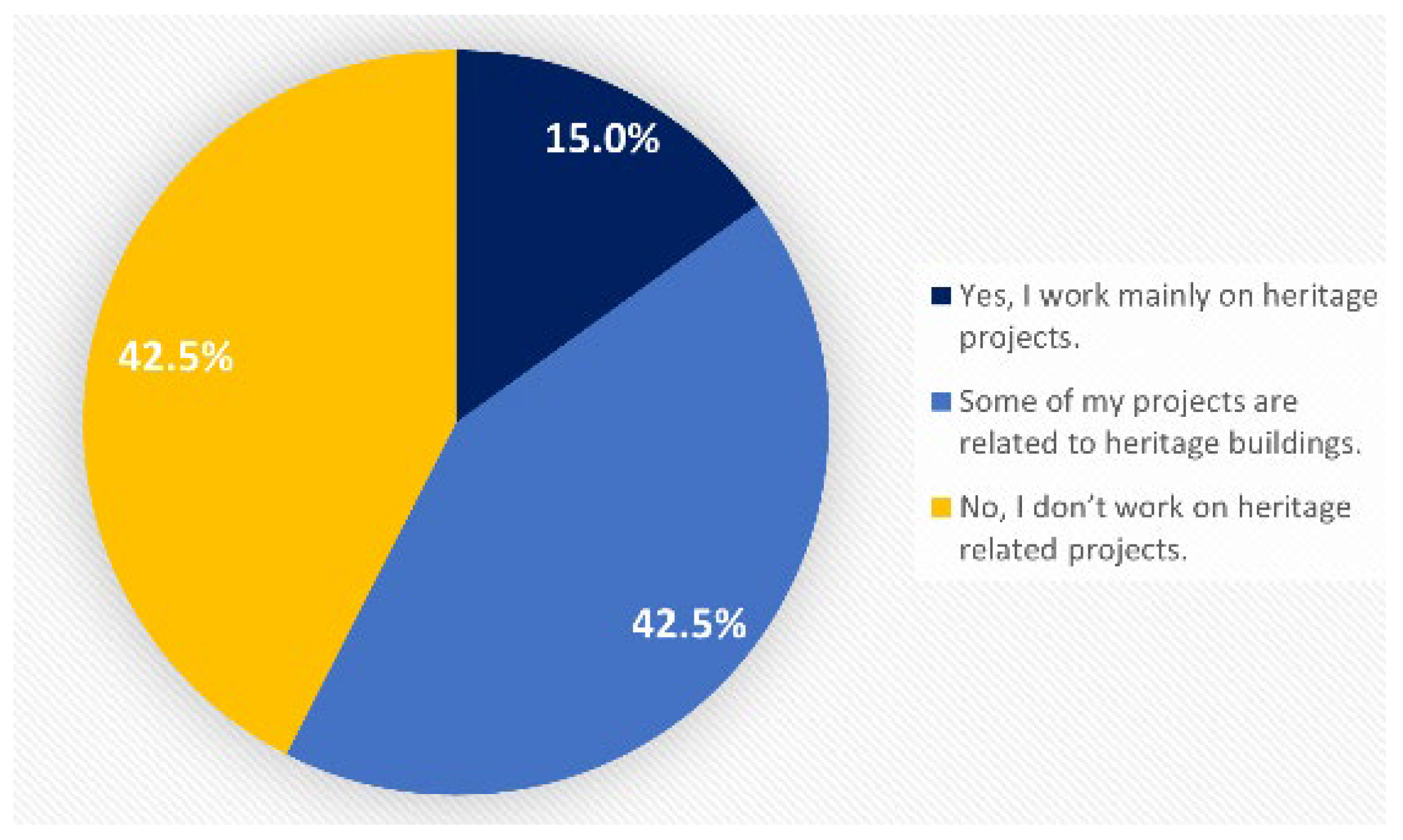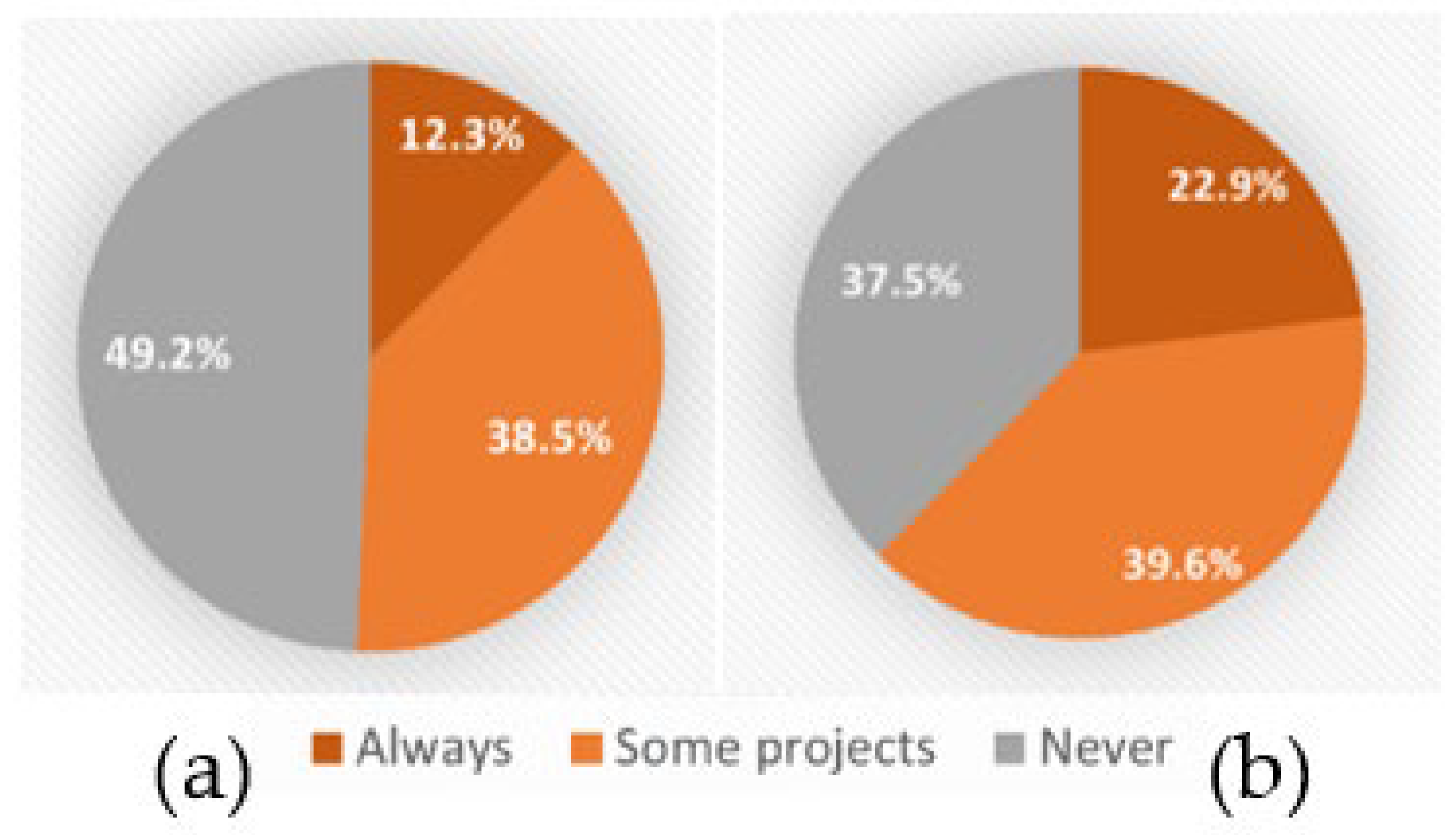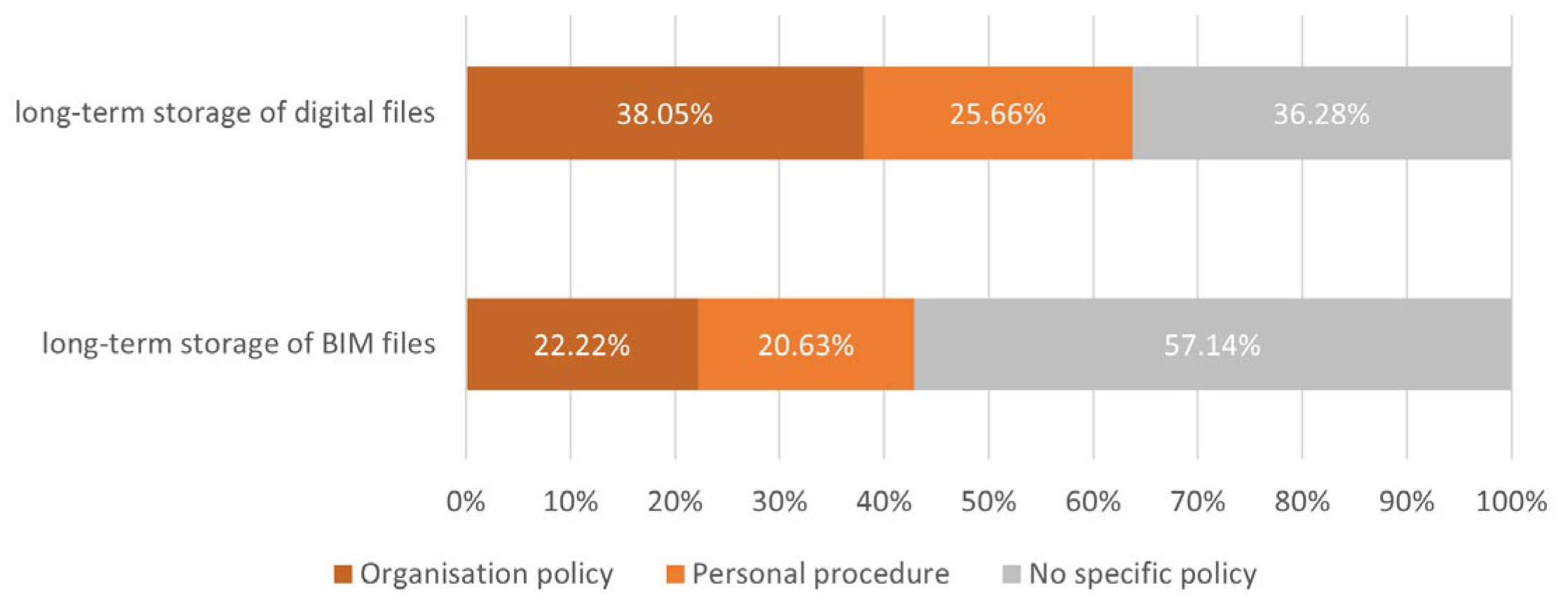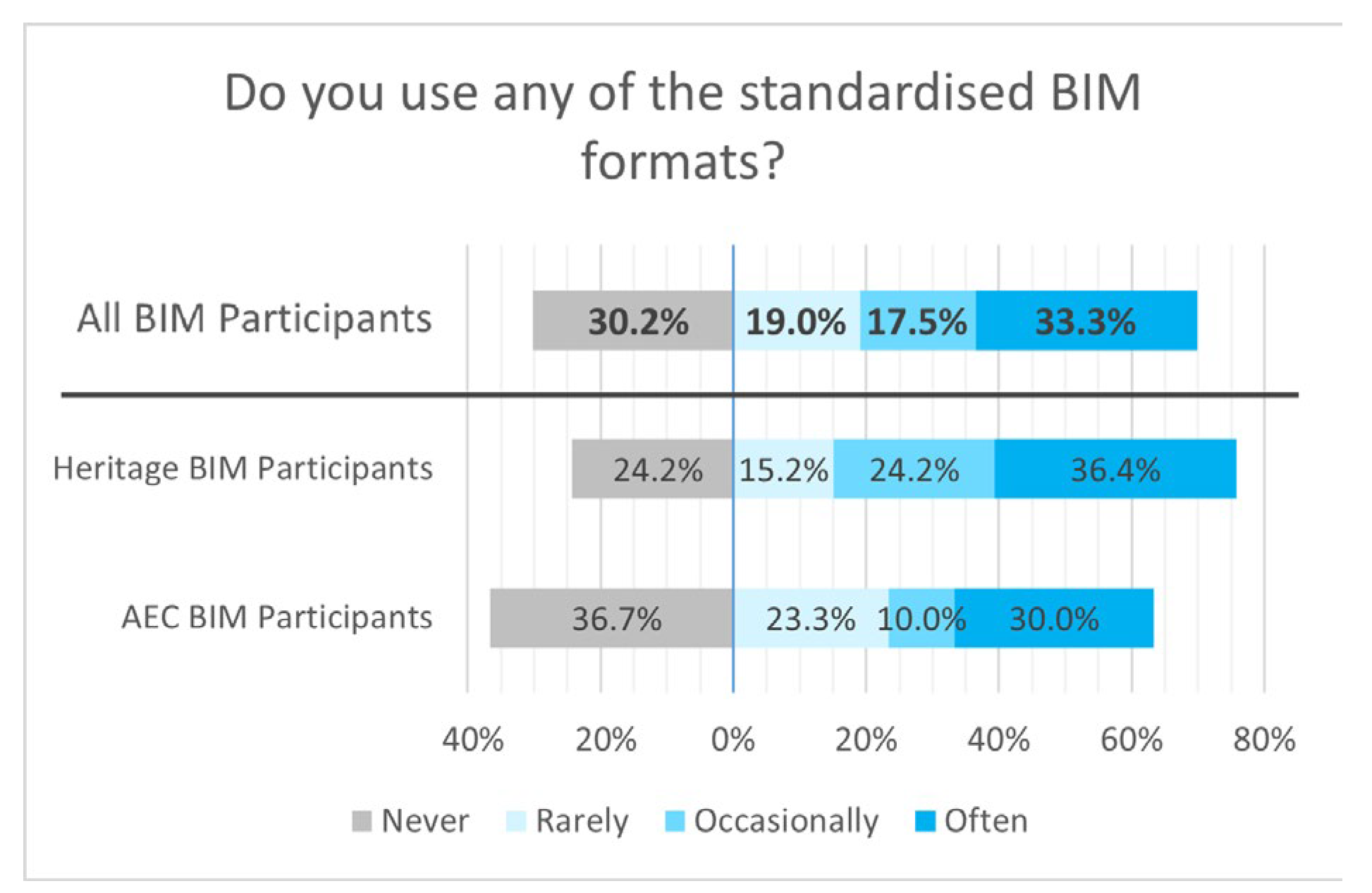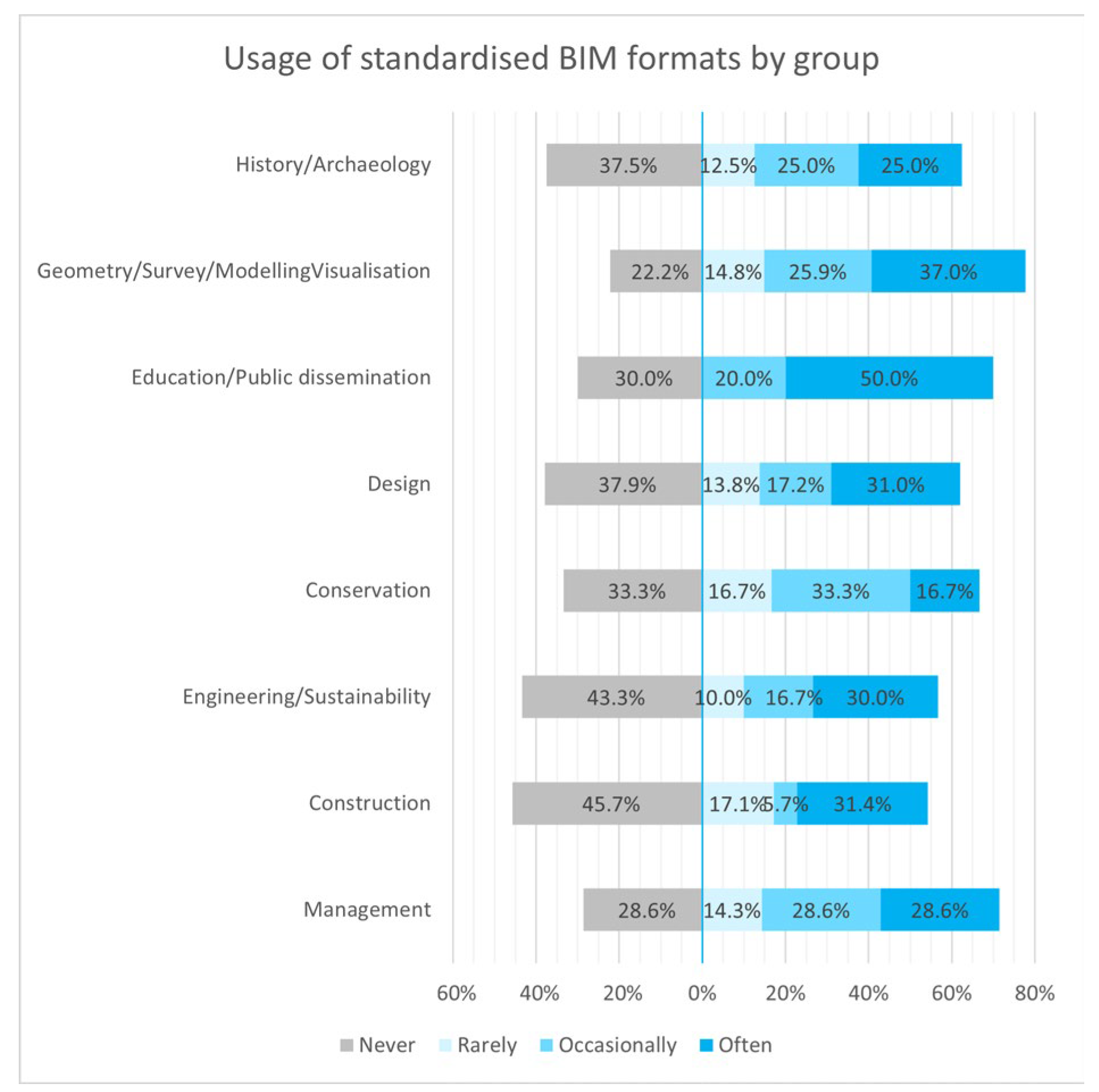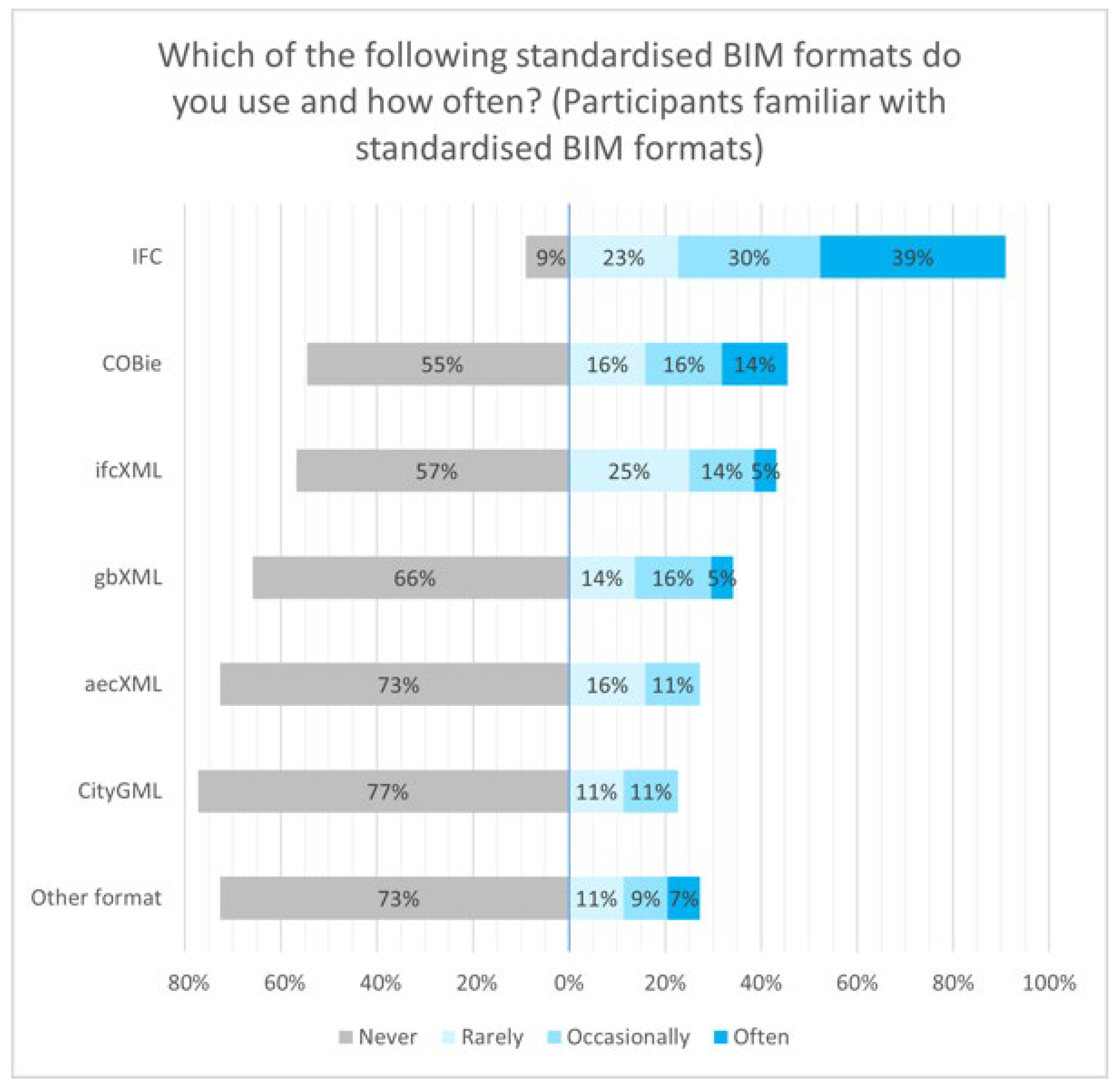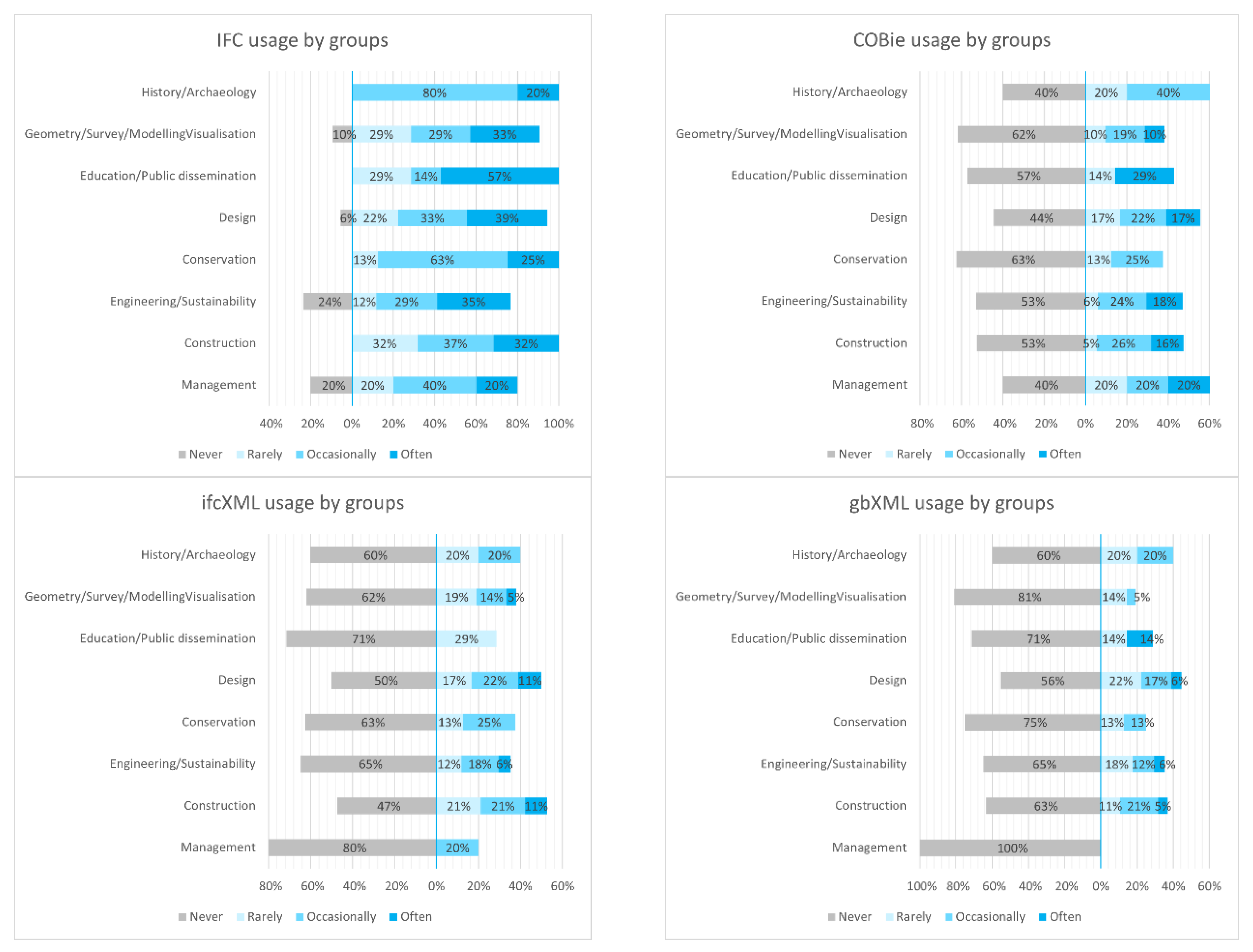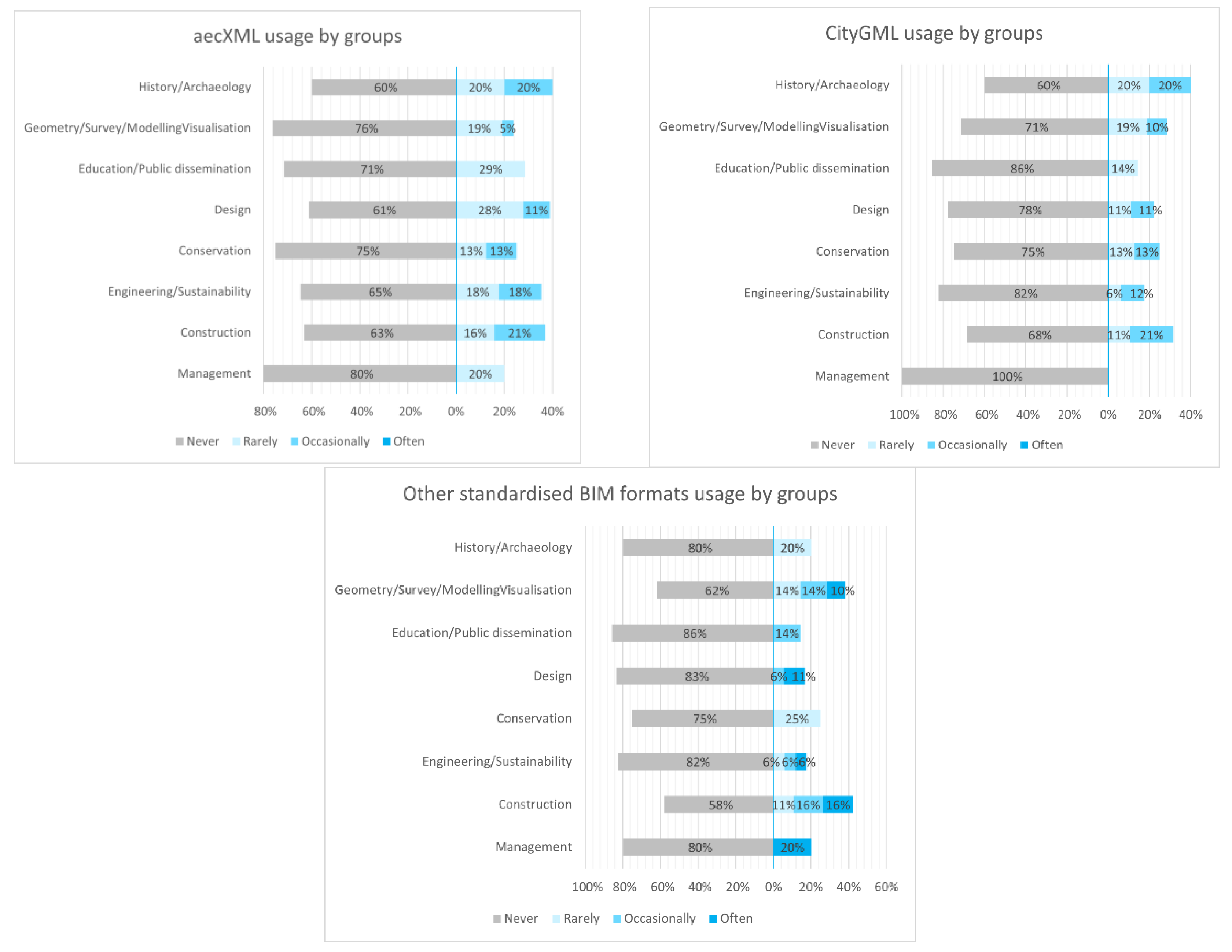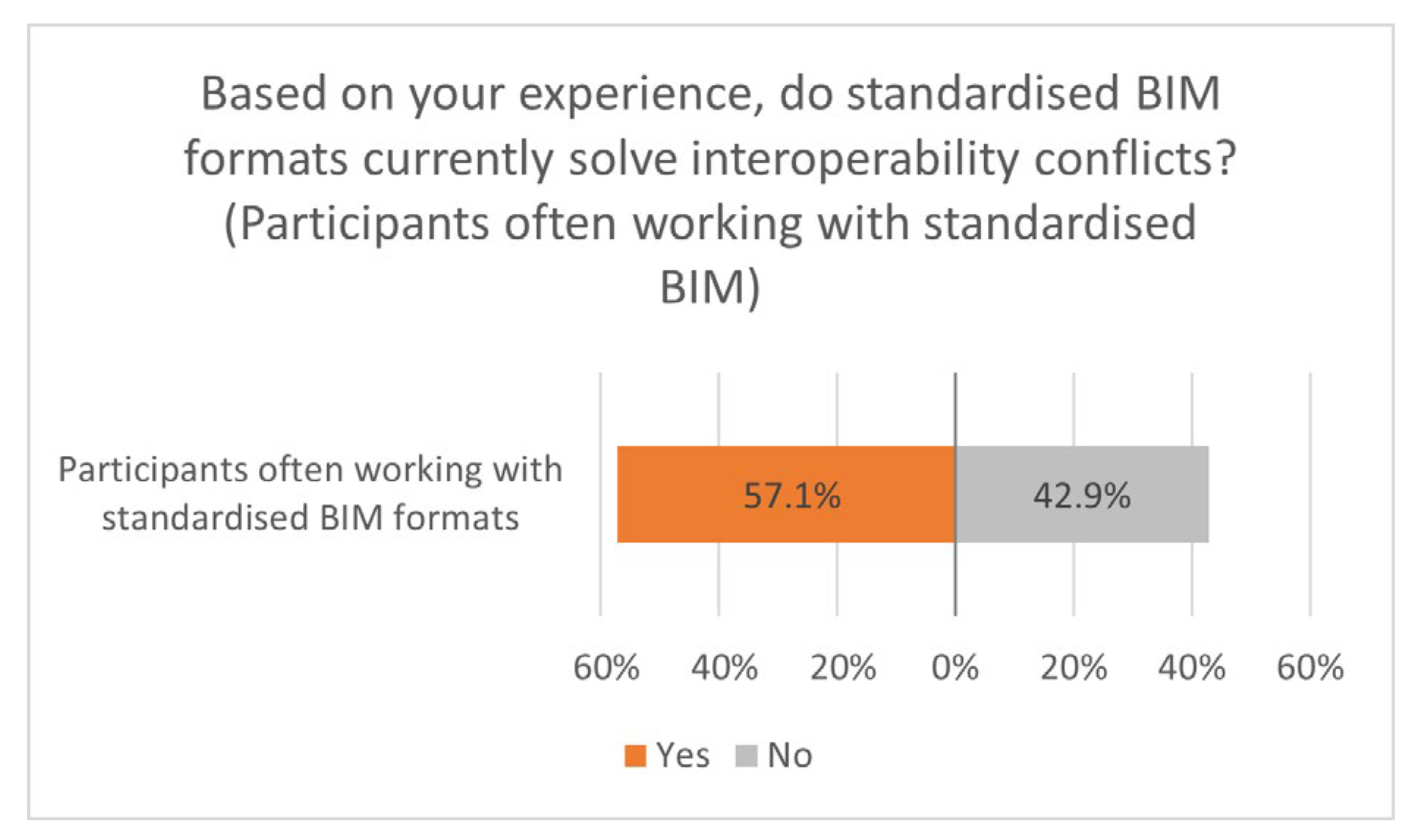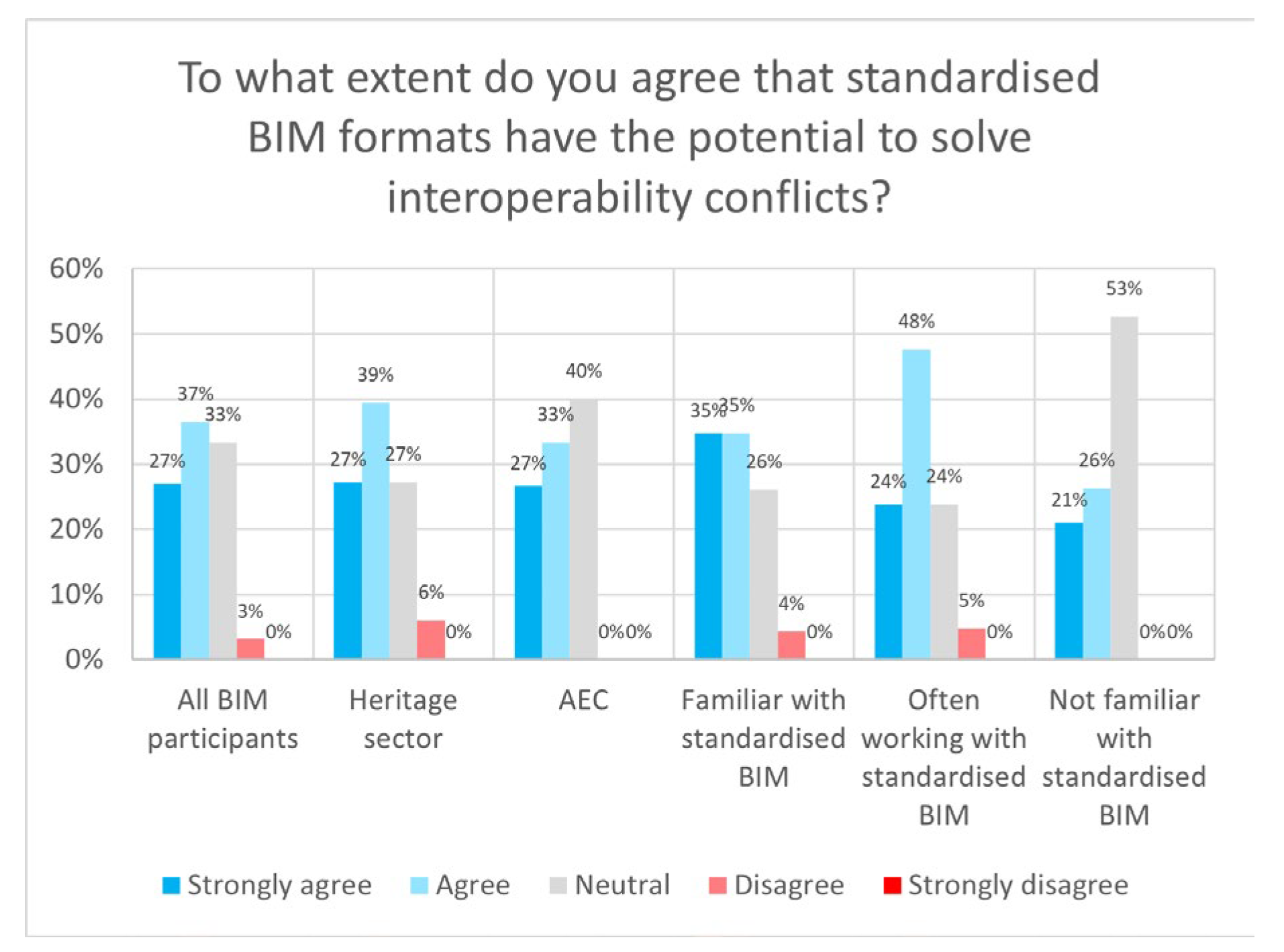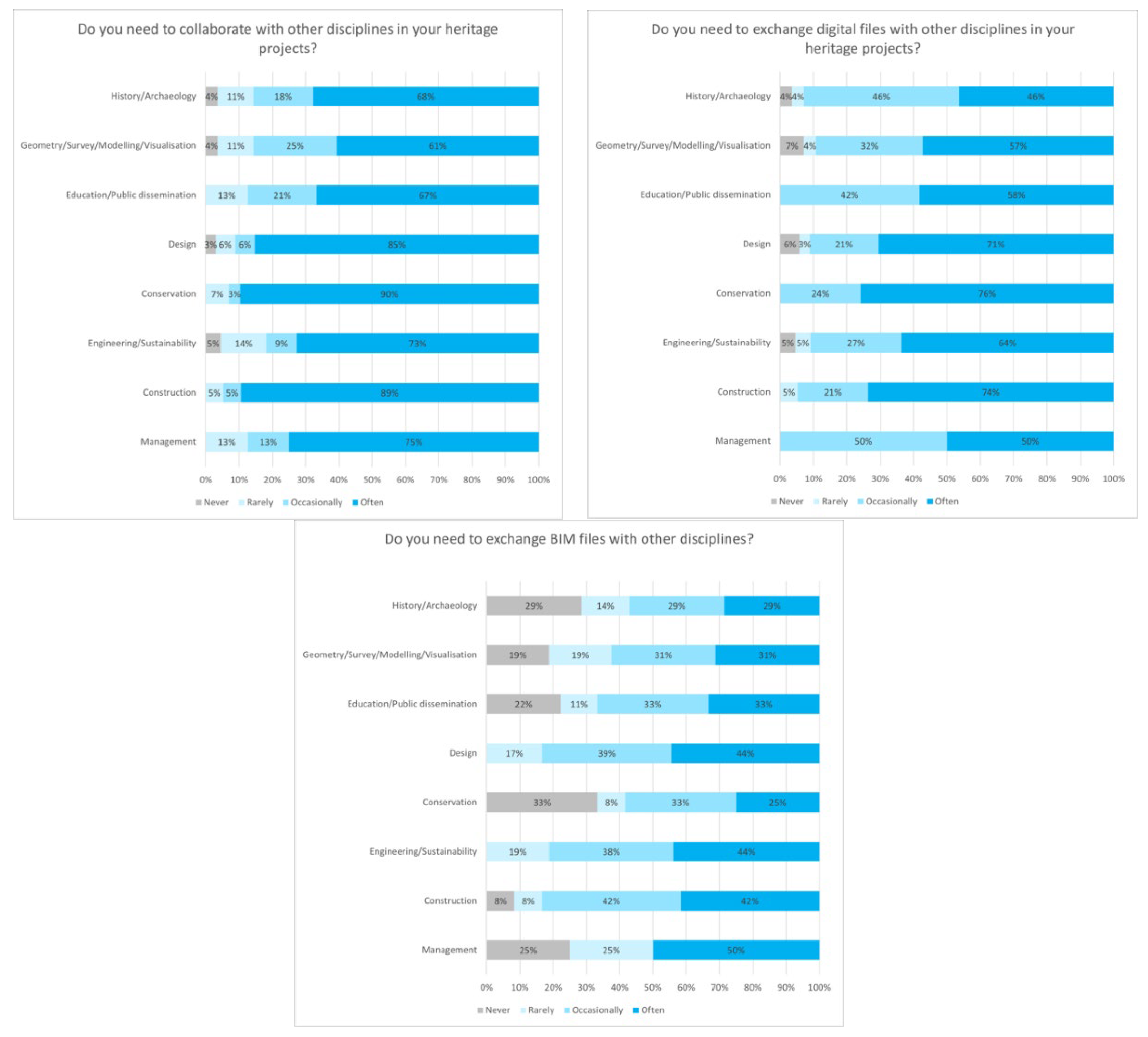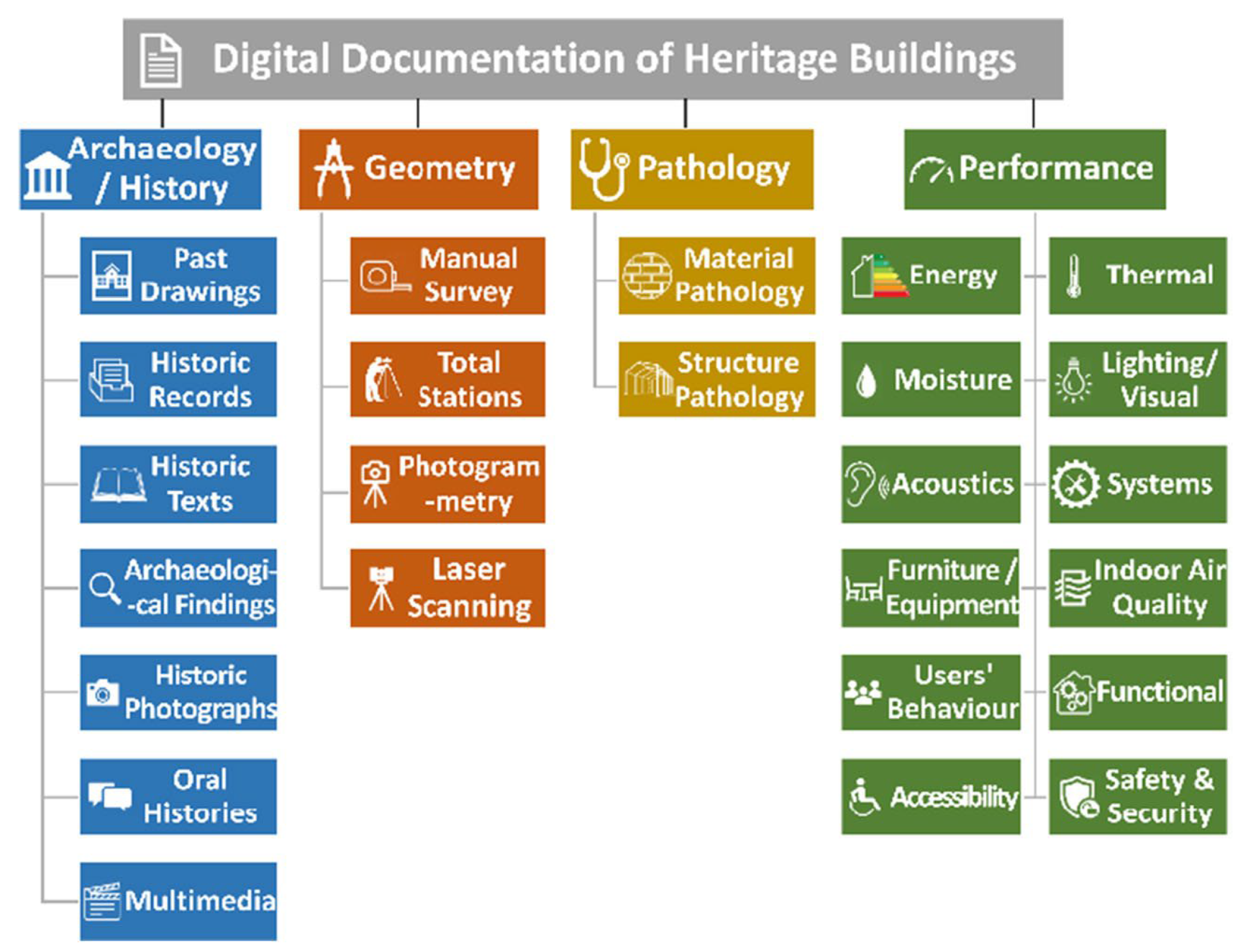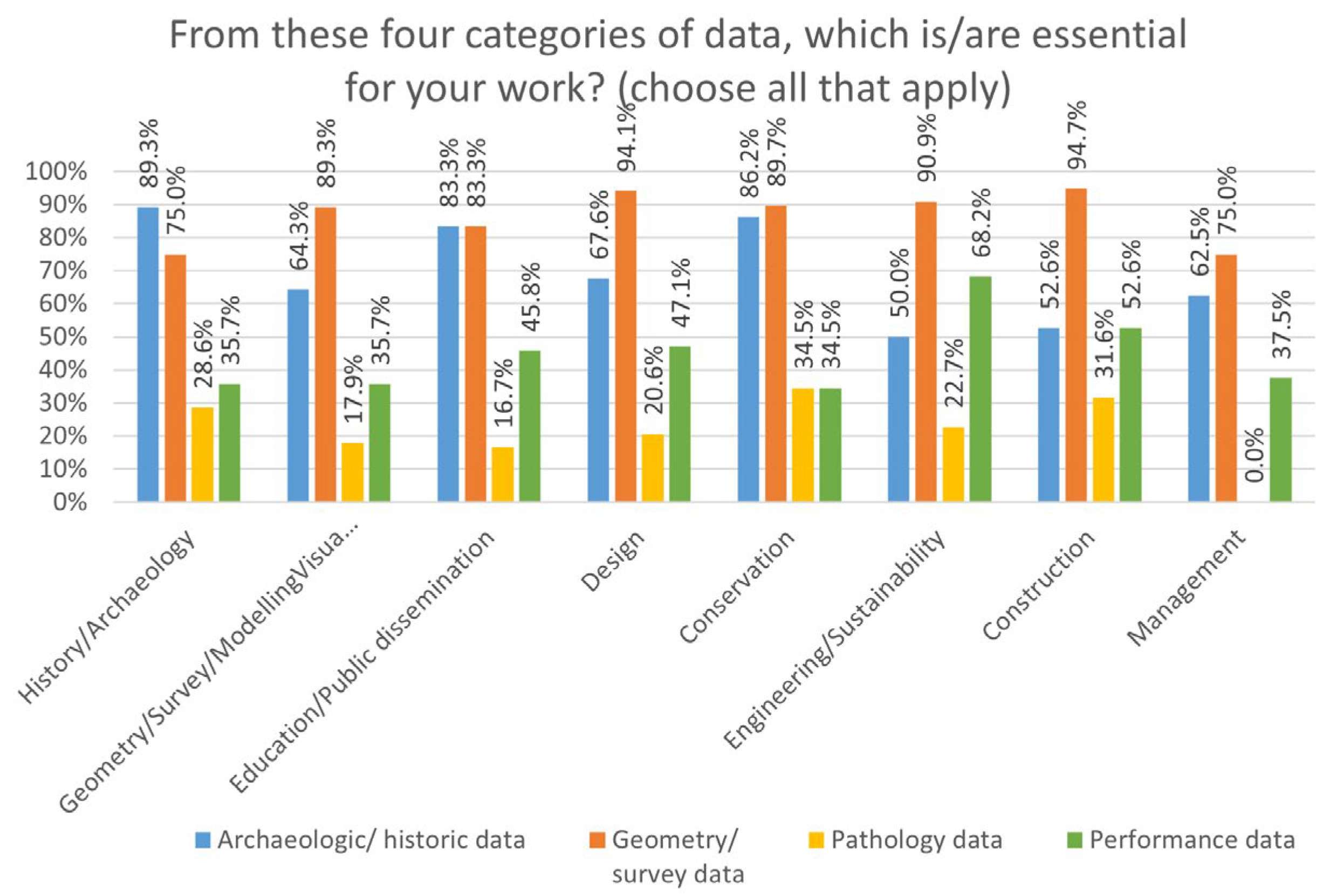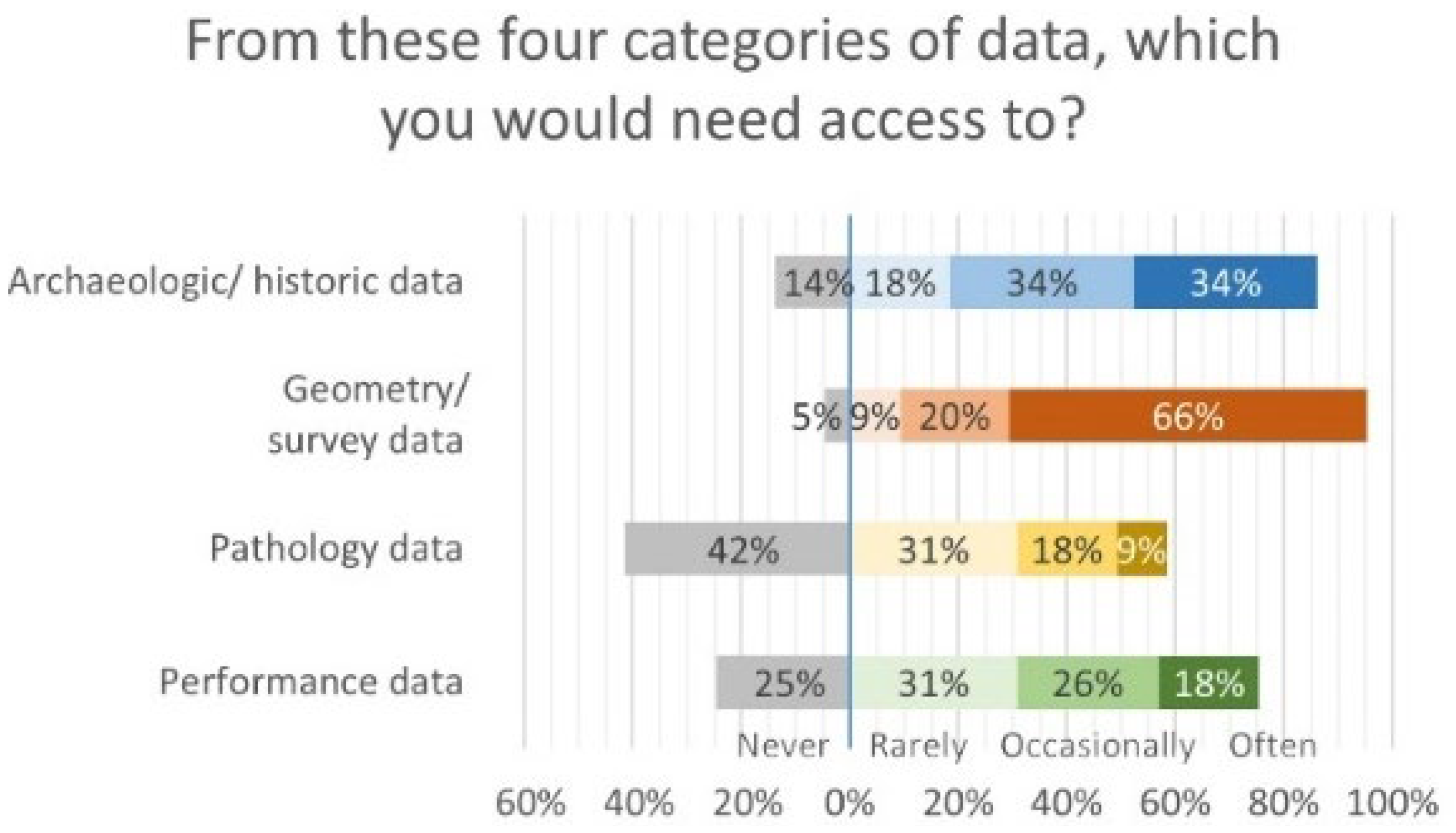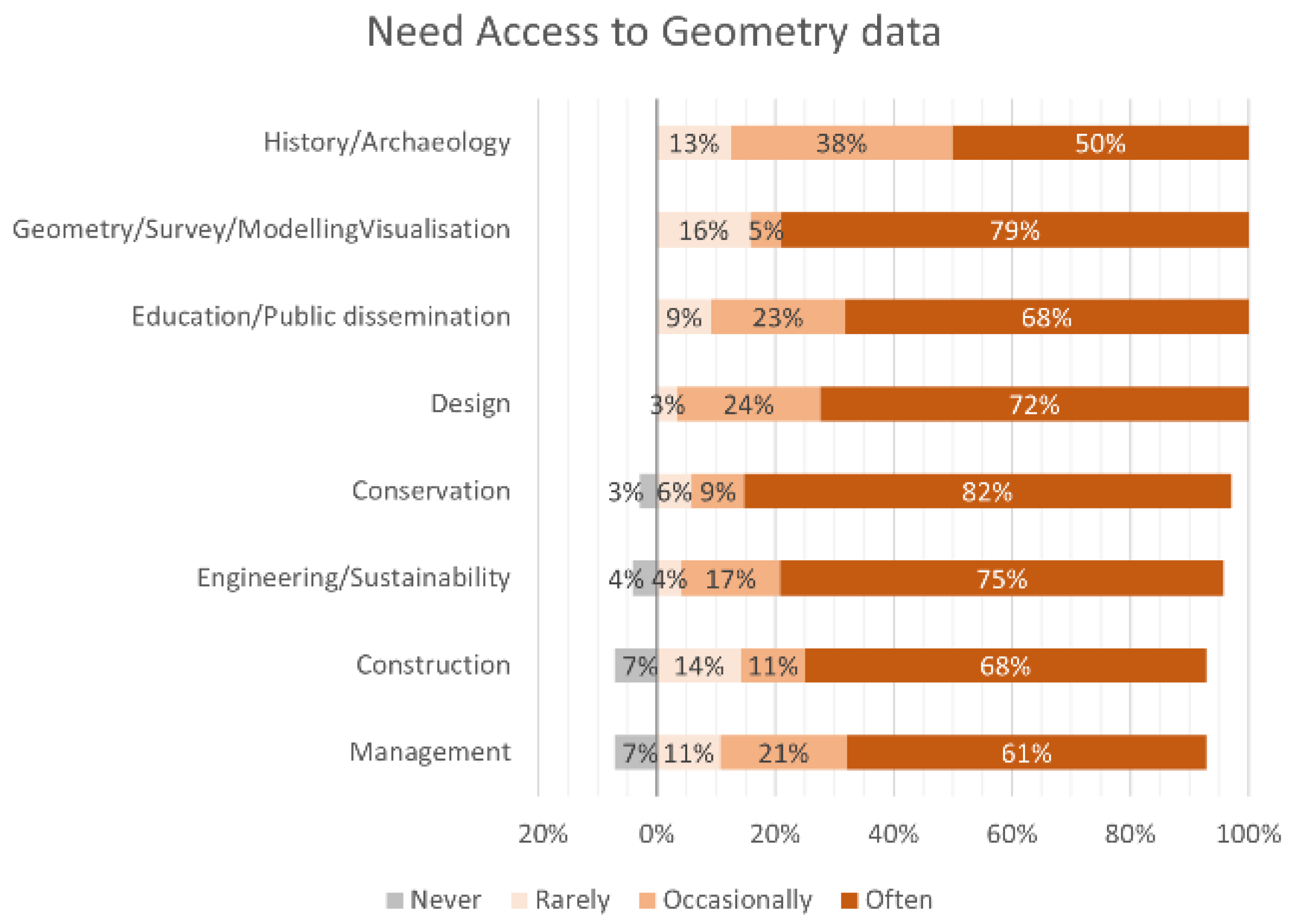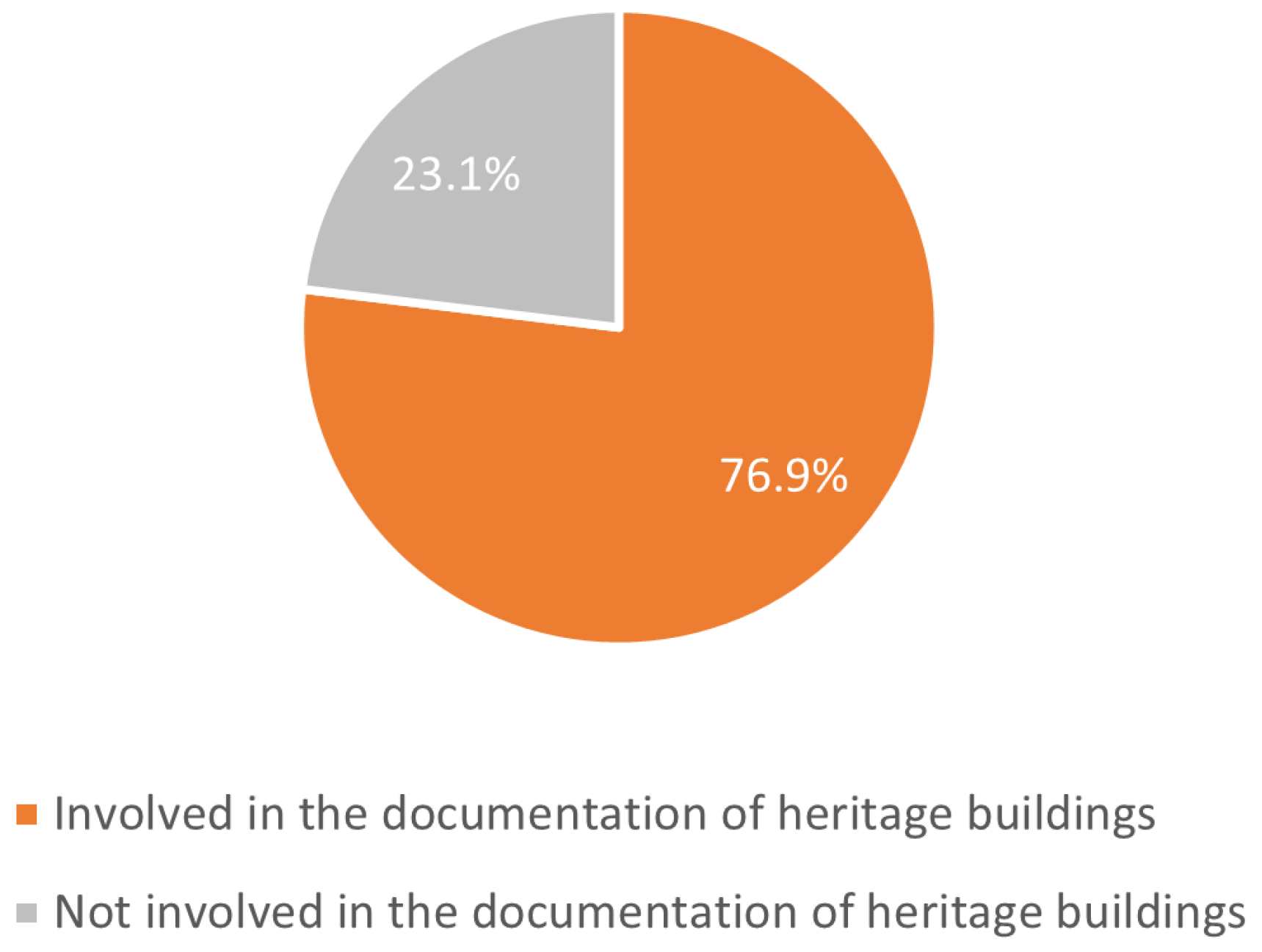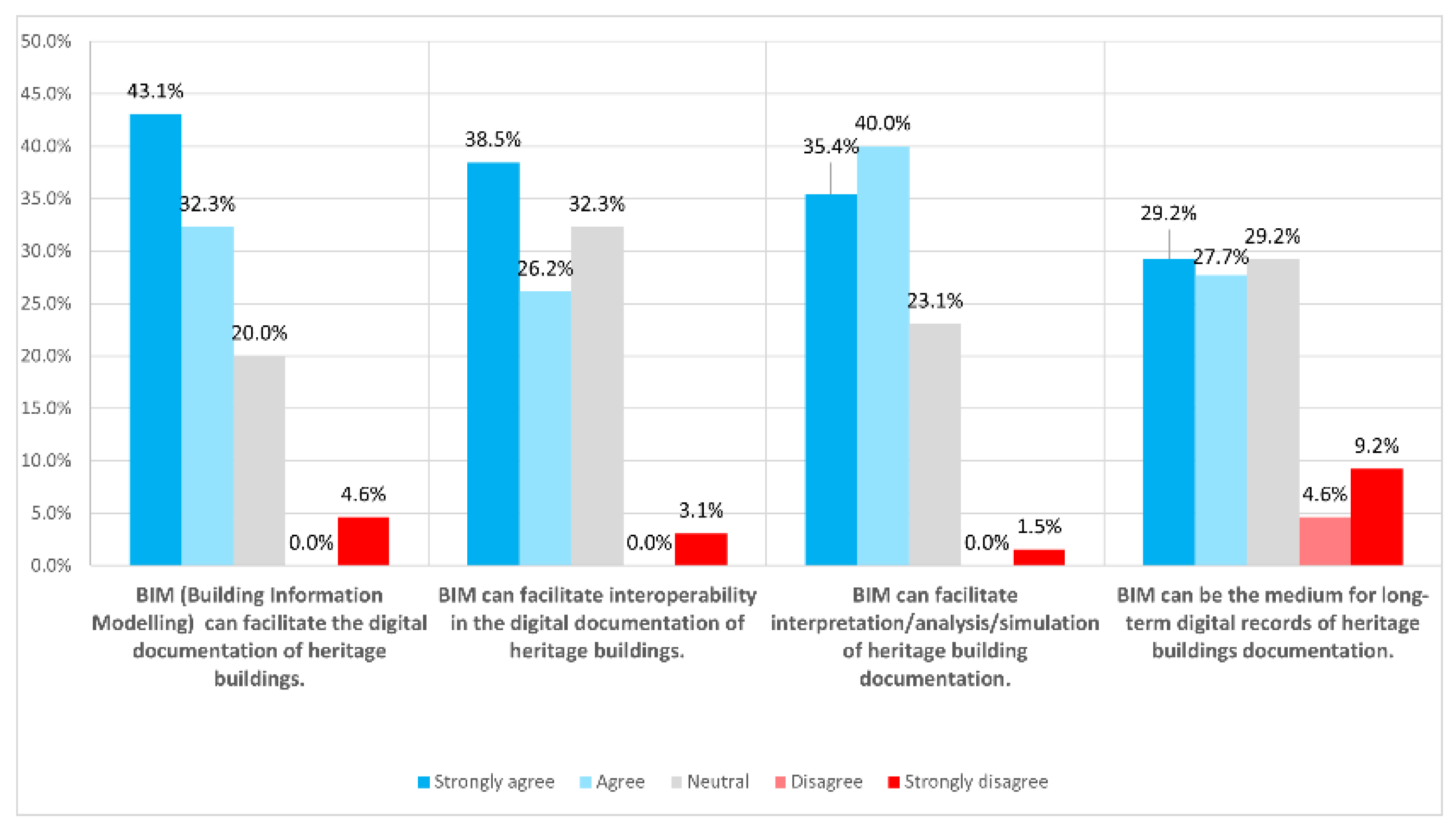2. Background and Related Work
One of the aims of the development of BIM was to create a new medium that can interpret and manage a variety of data types that were previously limited by their respective data formats. BIM introduced a solution for integration, interpretation, and management of such diverse data and consequently the integration of various disciplinary processes within the same platform.
The heritage buildings sector can greatly benefit from BIM applications. H-BIM (heritage building information modelling) emerged to facilitate the management of the conservation, renovation, retrofitting, and management of heritage buildings [
1].
H-BIM can represent many advantages for the historic buildings, which can be summarised mainly in the integrity of design and visualization, cost estimation, conflict detection, full planning implementation and improved stakeholder collaboration [
2]. It can also help in the documentation phase in automatic measurement, identification, and modelling of damaged or non-existent architectural elements [
3]. So, it can be a representation of the historic building changes over time. H-BIM can also represent a contribution towards energy analysis, economic analysis up to multi-thematic analysis within sustainability [
4].
H-BIM inherits all BIM characteristics as it can combine multi-dimensional visualisation with comprehensive, parametric databases and allows the integration of management of graphical and informational data flows as well as facilitating the collaboration among project partners to develop strategies of design, construction, and facility management [
5]. This helps to transform individual executors into teams and decentralise tools into complex solutions, which leads to individual tasks being implemented as complex processes; perform life cycle operations of a construction project more effectively, faster and with lower cost [
6].
While these characteristics are shared between new-build BIM and heritage buildings’ H-BIM, the prominent difference lays in the initial phases of documenting the existing and valuable fabric of the heritage building, which is usually coupled with irregular geometry, non-homogeneous materials, variable morphology, undocumented changes, damage, and various stages of construction [
7]. These challenges put more weight on the surveying, documentation, modelling, and visualisation phase in the process of H-BIM. These challenges lead to the development of H-BIM as a novel approach aiming to integrate the heritage buildings sector with its diverse stakeholders into BIM environment.
Building data should be accessible throughout the lifecycle of the building from design to construction to operation. A vital question is how these data could be interpreted in the future as the challenge of the longevity of data is an important consideration in data management. Longevity is considered as one of the main obstacles slowing the widespread adoption of BIM [
8]. A variety of factors can affect data longevity. However, the most prominent factors are linked to the fast-developing nature of the software market resulting in the continuous emergence of new software and consequently new proprietary formats that in some cases lead to the obsolescence of older software. This can inevitably lead to the loss of significant data created with outdated software. Moreover, even with the ongoing development of newer versions of the same software, there can still be issues with a loss of support for data created with older versions of the same software and the loss of accessibility to older data.
Challenges of data longevity could be greater to the heritage sector, compared to new buildings, as—alongside the preservation of the building itself—the digital data of the building should also be preserved and accessed for longer periods to act as a record of the building and its alterations over its lifespan [
9]. This is in contrast with new buildings that do not usually need a detailed historic record to be kept. In reality, the data of the heritage building should ideally outlive the building itself, to serve as an accurate representation and documentation of the building in case of any loss or damage to the building. This, coupled with the short lifespan and high development rate of digital software, means that current documentation stored on current data formats are unlikely to be readily usable in future developed software, which can undermine the ability of digital software data to be the medium for long term storage of heritage buildings documentation data. Therefore, the issues of data longevity and software obsolescence could represent much more prominent challenges in the heritage sector than any other sector within the AEC industries. Few studies discussed the issue of data longevity in the heritage sector, which represents a real challenge for the protection and storage of heritage buildings data.
Interoperability is basically defined in ISO/IEC 2382:2015 as “the capability of two or more functional units to process data cooperatively” [
10]. The BIM Interoperability Expert Group (BIEG) use a more stringent definition as “the ability of two or more systems to exchange information and to use the information that has been exchanged” [
11]. While the UK Government and Industry Interoperability Group (GIIG) expanded this definition to be “the ability of two or more systems to exchange information securely and to use the information that has been exchanged. This exchange must not require additional processing and must not be legally or technically restricted to specific software solutions” [
12]. BIM interoperability refers to BIM applications’ capabilities to share, exchange, gather, and process the same data via a common set of exchange formats, by using the same file formats and the same protocols [
13,
14]. BIM interoperability enables model sharing and linking data between different operators, and BIM applications ensure data consistency [
15]. Interoperability limitations between different platforms has been identified as the main obstacle to adopting BIM by the market since 2010 [
13] and it is still reported as such in more recent studies [
14,
16]. ISO 19650 is an international standard of good practice. It defines BIM information management principles and requirements within a broader context of digital transformation in the disciplines and sectors of the built environment, which aims to improve interoperability [
17].
In the software market, BIM developers work in silo to produce a variety of software that work in different ways and use proprietary file formats. This created a major challenge when different stakeholders need to communicate across different BIM software, and consequently it undermines the interoperability and integration between different project teams and their diverse data. Although, some developers, aiming for market dominance, provide wide packages of services of the same brand that are meant to work interoperably without the need for other platforms, other developers have instead aimed to consolidate specialised uses with relative niches of users and to synergise with other complementary tools for specialised uses. However, in reality, a project usually consists of many teams using different platforms that could not communicate seamlessly. This challenge led to a need for standardisation and transformation from a model with an internal data structure to a universal one that has to be adapted in another environment [
15]. Therefore, standardised open-source formats were developed to act as a universal format that can be exchanged and interpreted on various platforms. BIM standardised formats can be used throughout the whole pipeline, from the acquisition/creation of the 3D model and the related metadata to the processing and operation, until its storage in digital repositories [
18]. One of the main initiatives toward standardised BIM formats is BuildingSMART, which is an international organisation aiming to facilitate the development and adoption of open standards for infrastructure and buildings [
19].
Among the main standardised BIM formats are:
The Industry Foundation Classes (IFC) format, an open specification data format developed by the International Alliance for Interoperability (IAI) and currently promoted by BuildingSMART International. It is an open, international standard (ISO 16739-1:2018), meant to be vendor-neutral, and usable across a wide range of hardware devices, software platforms, and interfaces for many different use cases [
20]. It can facilitate the interoperability between various software to share the information of the model which can link operators in construction and engineering, such as in simulations and calculations [
21]. It uses four layers (resources, core, interoperability, and domain) to describe the geometry information, the material properties, and the relationships in a BIM model. However, he IFC format does not capture how information is created and shared by practitioners so some specific information will be missed in the exchange process [
22]. Moreover, BIM software developers typically export to the IFC format in distinct ways, adding an extra layer of complexity to the interoperability between software.
COBie (construction operations building information exchange) defines expectations for the exchange of information throughout the lifecycle of a Facility. The use of COBie ensures that information can be prepared and used without the need for knowledge of the sending and receiving applications or databases. It ensures that the information exchange can be reviewed and validated for compliance, continuity, and completeness [
23]. COBie information can be exchanged by using different open standard format such as IFC, ifcXML, and SpreadsheetML. The spreadsheet version of COBie is now widely accepted and can be exchanged with different commercially available software worldwide [
24]. COBie holds information about the spatial locations and the equipment and components that make up the Facility. To make these manageable during the Facility lifecycle, spatial locations are allocated to intermediate addresses or locations and into other spatial groupings, and equipment, and components are assigned their common specification and grouped by their functional purposes.
Extensible markup language (XML) provides enhanced readability and benefits from a broad range of software tools. ifcXML is based on the ISO standard for representation of STEP data in XML format ISO 1030-28 [
25], that specifies the mapping of EXPRESS language definitions to the XML schema and the associated serialisation of instance data files [
26].
The green building XML (gbXML) is a schema that facilitates the exchange of data between BIM and building performance simulation (BPS) tools to enable interoperability between disparate building design and engineering analysis software tools [
27]. gbXML was initiated in 2000 by a company called Green Building Studio for inclusion in aecXML, after 2009 gbXML become a stand-alone entity [
28]. However, the gbXML format is not mature enough and has been limited to being used in simple design solutions because of its inability to read complex geometries [
22,
29].
aecXML is one of the most popular and the biggest XML dialect for AEC industry, developed since 1999 by IAI (International Alliance of Interoperability). Its syntax is worked out by 7 working groups: Catalogues Working Group; Design/Specification/Scheduling/Costing Working Group; Facility Management Operations and Maintenance Working Group; Procurement Working Group; Project Management Working Group; Project News Working Group and Plant Working Group [
30].
CityGML is published by the Open Geospatial Consortium (OGC) since 2007, aiming to represent three-dimensional urban objects and permits a multi-scale management of the information useful for the representation of architectural heritage multi-faceted, multi-temporal, complex knowledge [
31]. The CityGML format is compliant with the ISO/TC211 standard about the geographic and spatial information management and foresee the use of the OGC Geographic Mark-up Language (GML) [
32].
BIM Collaboration Format (BCF) is an XML format that enables users to share fragments of BIM data, with attached comments and requests for changes, without the requirement of sharing the entire BIM model [
8]. BCF allows different BIM applications to communicate model-based issues with each other by leveraging IFC data that have been previously shared among project collaborators. BCF was created for facilitating open communications and improving IFC-based processes to more readily identify and exchange model-based issues between BIM software tools, bypassing proprietary formats and workflows [
33].
Due to the lack of interoperability between BIM and acoustic simulation tools, data are usually retrieved from a BIM model and used in acoustical simulation software such as EASE, Odean, and CATT-Acoustics [
34]. However, interoperability issues between the BIM software and acoustical analysis software limit the applications in practice. One possible solution to this problem can be performing acoustical simulations locally in the BIM software, though, the interoperability between different programs is practically non-existent since they rely on internally developed database formats [
35]. OpenMAT database project was initiated as a support for detailed description of materials and to provide acoustic professionals with an exchangeable database usable in acoustic simulation software [
36]. OpenMAT can store both numerical data and meta-information of the material in an open Extensible Markup Language (XML) format. The available data are absorption coefficients, scattering coefficients, the price of material, URL, a photo of materials texture, etc. Moreover, OpenMAT has both C++ and Python library for external coding [
35].
Stakeholders involved in heritage projects can represent a more diverse disciplinary spectrum than typical new built projects which are usually limited to typical teams of architects, engineers, contractors, and facility managers. Stakeholders involved in heritage projects can include, in addition to the above, more disciplines and specialities such as archaeologists, historians, surveyors, conservators, various levels of government bodies, museum curators, public dissemination professionals, as well as many specialised contractors. Every discipline and team involved can potentially use their own specialised tools and software. Another layer of complication lays in the fact that heritage projects are starting at an intermediate point in the asset’s life cycle, which can be much more complex than the relatively straightforward cradle-to-grave model that describes new-build construction [
37]. This makes heritage projects usually unpredictable due to insufficient or inaccurate older drawings, undocumented changes to the building, in addition to the risks and/or restrictions to perform invasive survey methods to study the structure and materials of the building. This could lead to mid-project changes in the project plan and introduction of new speciality teams to deal with the unpredicted problems or changes.
The issues of data interoperability have been highlighted in literature [
8,
11,
12,
13,
14,
15,
16,
17,
18,
22,
34], however, the literature is lacking data concerning the heritage buildings sector specifically. On the other hand, data longevity and data storage issues, especially in relation to heritage buildings sector, is seldom discussed in literature by their own, while the topic is usually discussed within other aspects [
8,
14,
18,
38]. Moreover, there is not enough recent data on the subjective opinions of users within the heritage and wider AEC industries concerning such issues. Therefore, in order to explore the current challenges and limitations related to data longevity, data interoperability and BIM standardisation, as well as quantifying their effects on the digital documentation of heritage buildings, the authors designed and conducted an online survey aiming to explore these issues within the heritage building sector and the wider AEC industries.
3. Methodology
An online survey was designed to explore potential problems of digital data storage, data re-accessibility, and potential challenges of BIM data interoperability in the heritage sector and the wider AEC industries, with the aims of: (1) To explore potential problems of digital data storage and re-accessibility, (2) To explore potential problems of BIM data interoperability, (3) To investigate problems related to digital documentation of heritage buildings, (4) To investigate potential benefits of BIM in the digital documentation of heritage buildings.
For the realisation of these aims a set of objectives were identified: (1) To assess the needs of the general AEC industry and of the heritage buildings sector for long term storage. (2) To explore issues of interoperability of BIM data. (3) To explore the extent of standardised BIM formats usage. (4) To compare BIM usage between heritage buildings sector practitioners and other practitioners in the AEC industry. (5) To evaluate the need for interdisciplinarity and interoperability between different disciplines involved in the digital documentation of heritage buildings. (6) To assess the needs of different disciplines to access different data types. (7) To assess the extent of BIM usage for all disciplines within the heritage buildings sector. (8) To measure the extent of BIM as a tool for digital documentation of heritage buildings that can facilitate the data management through the different processes related to the heritage building.
A total of 44 questions were designed to answer these objectives in both quantitative and qualitative approaches. The online questionnaire was divided into three sections (
Figure 1). The first section titled “Participant information” aimed to categorise the participants into appropriate categories: first categorisation is to identify participants working in heritage buildings from other participants within the AEC industries, in order to isolate the heritage sector participants and study responses that are specific to the area, and to compare their responses with other AEC participants that are not working in heritage related projects (titled in the study “AEC participants”). The second categorisation is to identify participants working with BIM and participants not working with BIM (
Figure 2). Additionally, within this section a question about work/research interests was aiming to associate participants with one or more of eight different groups: History/Archaeology, Geometry/Survey/Modelling/Visualisation, Education/Public dissemination, Design, Conservation, Engineering/Sustainability, Construction, and Management, in order to assess the variations in needs and challenges for each group.
The second section of the questionnaire titled “Digital data management” is divided into two parts: first part titled “Data longevity”, is asking questions about data formats, data storage, and data re-accessibility issues. The second part titled “BIM data interoperability”, is relevant only to BIM participants (
Figure 1). Within this part a third categorisation of participants takes place based on working with standardised BIM formats (
Figure 2).
The third section “Heritage Buildings Digital Documentation” is only relevant to participants identified as heritage sector participants. This section is aiming to explore the views of heritage participants towards interoperability issues and the use of BIM in the documentation of heritage buildings, as well as exploring the different data categories and the relations of different groups to them (
Figure 1).
The questionnaire was published online on the Microsoft Forms platform and invitations for participation were sent by email to organisations, companies, and individual experts of a relevant field (i.e., architecture, archaeology, architectural history, construction, building service engineering, sustainability, heritage conservation, heritage management, 3D modelling, BIM, visualisation, and facility management) targeting individuals from both academic and professional backgrounds. Furthermore, invitations to the questionnaire were published online on LinkedIn and relevant Facebook groups. Participation was not geographically restricted, as the issue of data longevity and interoperability is global. Some organisations published the survey invitation through their members’ newsletters and/or online members’ groups such as ICOMOS-UK (International Council on Monuments and Sites), IHBC (Institute of Historic Buildings Conservation), CIBSE (Chartered Institution of Building Services Engineers), and CIPA Heritage documentation.
Received responses were analysed using Microsoft Excel software for quantitative data analysis and QSR NVIVO software for qualitative data analysis. The results of the online survey will be presented in the next section followed by a discussion of the findings.
5. Discussion
Data longevity and interoperability issues could be more challenging for the heritage buildings sector than any other sector within the AEC industries, this is because of the nature of heritage projects that usually requires much wider interdisciplinary involvement, in addition to the value of the heritage building data that could be on its own an asset to be preserved. However, more research is needed to help better understand these differences.
No available earlier research taking the approach of quantitative and qualitative survey were found. Therefore, the authors designed this online survey to try to examine this hypothesis and explore aspects of differentiation between the heritage sector and other AEC sectors. The online questionnaire aimed to explore three areas: firstly, the data longevity and data storage challenges, secondly the BIM interoperability issues and challenges including assessing the efficiency of standardised BIM solutions, and thirdly to explore challenges of the digital documentation of heritage buildings by analysing the needs for different data categories and the needs for data collaboration, as well as exploring the stance of heritage participants towards BIM. A total of 113 valid responses were received leading to interesting results. Participants were categorised into heritage sector participants and AEC participants, this is followed by a second categorisation into BIM participants and non-BIM participants, while BIM participants were further categorised into not working with standardised BIM formats, familiar with standardised BIM formats, and often working with standardised BIM formats. In terms of research/work interests, participants were associated with one or more of eight groups of disciplinary interests: history/archaeology, geometry/survey/modelling, education/public dissemination, design, conservation, engineering/sustainability, construction, and management. It was noted that heritage sector participants tend to be associated with more interest groups than their AEC counterparts, as 37% of heritage participants were associated with more than three groups compared to only 8% of AEC participants, which highlights the complexity and interdisciplinary nature of the heritage sector.
The objectives of the online questionnaire were: (1) To assess the needs of the general AEC industry and of the heritage buildings sector for long-term storage. (2) To explore issues of interoperability of BIM data. (3) To explore the extent of standardised BIM formats usage. (4) To compare BIM usage between heritage buildings sector practitioners and other practitioners in the AEC industry. (5) To evaluate the need for interdisciplinarity and interoperability between different disciplines involved in the digital documentation of heritage buildings. (6) To assess the needs of different disciplines to access different data types. (7) To assess the extent of BIM usage for all disciplines within the heritage buildings sector. (8) To measure the extent of BIM as a tool for digital documentation of heritage buildings that can facilitate the data management through the different processes related to the heritage building.
5.1. Data Longevity and Data Storage
One of the objectives of the online questionnaire is to assess the data longevity needs for the heritage buildings sector and evaluate its urgency in comparison to the wider AEC industry. The responses showed higher needs of the heritage sector participants for future re-accessibility of digital data as 82% stated that they need to re-access their projects after completion compared to 69% of AEC participants. However, BIM future re-accessibility needs were less obvious (67% of heritage BIM participants and 60% of AEC BIM participants). This may suggest that although 51% of heritage participants are working with BIM, BIM could be still not the medium used for the whole lifecycle of the heritage project and not the medium usually used for long-term data record.
The questionnaire results suggest that BIM data longevity is a serious issue as 43% of BIM participants have already encountered some problems in accessing older BIM data. In total, 33% of BIM participants reported facing re-accessibility problems due to the use of different versions of the same software which suggests that the fast-developing software market could actually be a restriction for BIM data longevity. A total of 19% of BIM participants reported corrupt files as a reason for not being able to access older data, which highlights the challenges of robust data storage solutions. In total, 16% of BIM participants reported having problems accessing older data because they are using different software than the ones used in creating the data, which highlights the interoperability issues and the need for universal data formats that are not restricted to a specific platform and could be interpreted in various software solutions.
Data storage procedures were investigated within the online survey. A total of 38% of all the participants stated that their organisations are following some sort of established policy for long-term storage of data. A further 26% were following their own personal preferred procedures. This leaves a 36% of all the participants who reported having no policy for long-term data storage, which is a very high percentage considering the value of digital building data, especially for heritage buildings.
The main policies highlighted in the participants responses included archiving on external drives, cloud-based storage, off-site storage, storing both original files and pdf prints, and one participant suggested that data should be stored in the concerned building itself rather than the company doing the work.
Many concerns have been highlighted in the participants comments about data longevity challenges including: data size, storage expenses, the short lifespan of software updates, data format obsolescence, outdated storage technologies, lack of identified storage policy, lack of defined storage responsibility between stakeholders, problems of archiving and locating the data. Some comments were specific to BIM data storage including: low BIM adoption, reluctancy of some stakeholders to release BIM models, improper workmanship or BIM administration, immaturity of BIM to be adopted as a long-term data storage. Some participants presented solutions and suggestions concerning long-term data storage included: storage requirement agreement at the beginning of the project, BIM details agreement at start, assigning an information manager from the facility management team to be in charge of keeping access to the data, regular update and conversion of the data to the latest accessible format, stored data should follow FAIR protocol (Findable, Accessible, Interoperable, Reusable). Some participants stressed on the benefits of cloud-based storage, some advised of storing data in link SQL, some insisted on storing native file formats, while some participants argued that paper is still the most efficient data storage medium due to the inevitable obsolescence of both data formats and digital storages medias.
5.2. BIM Adoption
Among the objectives of the research is to compare BIM usage between heritage buildings sector practitioners and other practitioners in the AEC industry. The results revealed that heritage sector is still behind the AEC industry in adopting BIM as 51% of the heritage participants use BIM including only 12% who are always relying on it, compared to 63% of AEC participants using BIM including 23% always using it. This could also be highlighted in many comments of heritage sector participants in the qualitative questions. This latency in BIM adoption in the heritage sector could be a result of many factors including more complexity in heritage projects, more interdisciplinary interaction in the heritage sector, and the limitations of H-BIM.
In response to the research objective aiming to assess the extent of BIM usage for all disciplines within the heritage buildings sector, the results showed a wide variation in BIM adoption between different disciplinary groups from 27% to 79% BIM usage. History/archaeology and education/public dissemination groups were the lowest in BIM usage, followed by conservation, management, design, and geometry/survey/modelling/visualisation groups, while construction and engineering/sustainability groups were the highest in BIM adoption. However, for the use of standardised BIM formats geometry/survey/modelling/visualisation was the highest this could be due to the complexity of the geometry capture procedure, especially in the heritage sector, and the fact that geometry data is usually the base for other disciplines to work upon.
5.3. BIM Interoperability
An objective of the online survey was to explore issues of interoperability of BIM data. The questionnaire results showed that the heritage sector is more prone to interoperability issues between BIM and other data formats than the general AEC industries, as 52% of heritage BIM participants reported interoperability issues compared to only 27% of AEC BIM participants reporting such issues. Concerning the conflicts between BIM and non-BIM data, the main issue mentioned by the participants was related to importing CAD formats into BIM software. Furthermore, 67% of heritage BIM participants reported interoperability issues between different BIM software, versus 50% reported by AEC BIM participants, highlighting the increased issues faced by heritage participants.
The qualitative comments of the participants showed that the most alarming issue concerning BIM data interoperability is the loss of data fidelity due to translation between BIM and non-BIM software. Another common statement is that the complexity of BIM makes it unlikely to be the common global standard in its current format. Additionally, some participants mentioned the latency in BIM adoption, especially in the heritage sector, and the need to introduce it to more users. Some participants addressed the deficiencies of the standardised BIM formats, while one participant suggested that it would be more effective if all software developers adopted a single format that could be shared within any platform.
5.4. BIM Standardised Formats
Recent standardised BIM formats that can be interpreted within different BIM software could be a solution to mitigate BIM interoperability issues and facilitate collaboration between various stakeholders. Exploring the extent of standardised BIM formats usage was among the objectives of the questionnaire. The survey results suggest that 76% of heritage BIM participants and 63% of AEC BIM participants have used standardised BIM formats in some capacity.
91% of the participants who use standardised BIM formats reported using IFC including 39% reporting frequent usage. Other standardised BIM formats such as COBie, ifcXML, gbXML, and BCF followed in terms of usage with significantly less percentage of usage. For the disciplinary groups’ breakdown, IFC was most relevant to history/archaeology, conservation, construction, and education/public dissemination groups. While COBie was most relevant to management group, ifcXML most used by construction and design groups, and gbXML was associated with design, construction, and engineering/sustainability groups.
The views of participants towards standardised BIM formats were overall positive as 72% of participants that are often working with standardised BIM formats agreed that standardised BIM formats have the potential to solve BIM interoperability conflicts, while only 57% said that they are currently successful in solving BIM interoperability conflicts.
5.5. Heritage Sector Digital Data Usage
The fifth objective of the research was to evaluate the need for interdisciplinarity and interoperability between different disciplines involved in the digital documentation of heritage buildings. The survey results confirm that interdisciplinary interaction is a crucial factor in the heritage buildings sector, as 95% of the heritage sector participants acknowledged that they require some level of collaboration with other disciplines in their heritage projects, including 69% that often rely on this collaboration. While there are some differences between different disciplinary groups in interdisciplinary requirement, between 61% and 90% often require interdisciplinary collaboration, the highest percentages were in the conservation, construction, design, and management groups.
Data interoperability in heritage sector is similarly emphasised in the results of the questionnaire as 94% of the heritage participants are in need of digital data exchange with other disciplines in some of their projects, this includes 62% who stated that they often need such digital data exchange. The highest groups that often require data exchange were construction, conservation, and design groups.
In terms of BIM data exchange, 85% of heritage BIM participants acknowledged that they would need to exchange BIM data in some of their projects while only 36% addressed BIM data exchange as often required. This discrepancy between the digital data exchange requirements and the BIM data exchange requirements can be understood as a result of latency of BIM adoption in the heritage sector that some teams in the project could be using BIM but they need to exchange information in non-BIM formats with other project teams that are depending on pre-BIM digital workflow. The latency of BIM adoption in the heritage sector can also be observed in the comparison of BIM adoption in the questionnaire responses between the heritage sector and AEC, as only 51% of the heritage participants are using BIM in some capacity compared to 63% of the AEC participants.
Heritage participants showed their approval of 75% that BIM can facilitate the digital documentation of heritage buildings. 65% approved that BIM can facilitate interoperability in the digital documentation of heritage buildings. 75% approved that BIM can facilitate interpretation/analysis/simulation of heritage buildings documentation. The statement that BIM can be the medium for long-term digital records for heritage buildings documentation, received the least approval percentage as only 57% of the participants agreed while 14% disagreed, which suggests less overall confidence compared to the other statements.
Digital data related to heritage buildings can be categorised into four categories: history/archaeology data, geometry data, pathology data, and performance data. The need for different data categories can vary between the various disciplines involved in heritage projects [
9]. One of the objectives of this online survey was to investigate these differences. The questionnaire results suggest that the geometry data category is by far the most essential data by almost all the interest groups and the most data they needed access to. The archaeologic/historic data category was essential for the history/archaeology, education/public dissemination, conservation, and design groups. The pathology data was most essential for the conservation, construction, and history/archaeology groups. Performance data was essential for the engineering/sustainability, construction, design, education/public dissemination, and management groups.
5.6. Digital Documentation of Heritage Buildings
77% of the heritage participants acknowledged they are involved in the process of digital documentation of heritage buildings. They have shared their views concerning the challenges facing the digital documentation process, where their comments were related to four areas: pre-documentation, documentation process, data management, and post documentation.
The pre-documentation challenges were concerned with the vision behind the documentation, determination of the project requirements and standards. Other concerns were related to the disparity of data sources and data accessibility problems. The challenge of inaccurate as-built and older drawings was also mentioned. Finally, some responses highlighted the challenges of physically accessing buildings and all their areas.
The reported challenges of the documentation process included limitations to the availability of budget, time, and technology. The challenge of accuracy of documentation, the details and complexity level of the building, as well as the size of the point cloud produced. Challenges of some hard to capture and document aspects such as documenting the intangible values of the building, documenting the building condition, and the challenge of performing a structural survey and documenting historic construction methods and materials were also reported.
The data management comments were mainly revolving around data interoperability, lack of consistency of BIM platforms, and the need to migrate data to standard BIM formats. Additionally, some comments mentioned the challenges of data size, the archive management, and the need to create information banks.
Finally, the post-documentation comments discussed two main challenges. Firstly, the challenges of data longevity and the potential obsolescence of file formats. Secondly, the challenges of data accessibility to clients, and users, while one participant argued that data about heritage buildings documentation should also be accessible to researchers, and to the general public.
Heritage participants views concerning the ideal medium for long-term storage of heritage buildings digital documentation for future access varied and branched into various trends. Some views argued that every heritage building is different and hence the needs of every case should be considered individually. Some arguments were based on the duration the stored data should ideally survive, which was suggested up to 50 years+.
Some participants argued that the stored documentation should be as simple as possible, some suggested that heritage buildings documentation should be kept in document formats such as pdf or paper prints. Another view debated that a mixed-type documentation is more efficient, such as storing the native file formats in addition to a more reliable or easy to use format such as document formats or a web-based accessible models.
On the other hand, many participants stated that a heritage building documentation should be in a digital form. Several said it should be stored in a cloud-based storage. For the form of documentation some participant stated it should be a 3D model, other view suggested GIS as a tool for storing heritage buildings information. BIM was mentioned by many participants as an ideal medium for long-term digital documentation of heritage buildings, while some views were sceptical that BIM, even though it has the potentials, is not efficient enough in its current status. Some participants even suggested that BIM complex models should have the ability to be accessed by non-BIM users to widen its accessibility within different stakeholders.
Some participants preferred to define their idea about the ideal medium for long-term documentation of heritage buildings without naming a specific solution, such as: “A platform able to store a model and data from multiple formats with the ability of real time simulation.”, “A platform that is user friendly and accessible to everyone.”, “Linked data models, that reference specific models for different kinds of information.”.
Another topic discussed in the comments is the update of data, either by a tool that automatically updates file formats according to their software updates, or an obligation for the facility management team to be responsible on keeping the data updated.
Accessibility of data was also discussed in the comments. Some views stated that after a period of time heritage buildings documentation data should be stored by a secured and reliable public body for public accessibility and future research. Other participants stressed that documentation data should be in form of open-source standard data. Another view suggested that documentation data could be incorporated in a Metaverse world.

